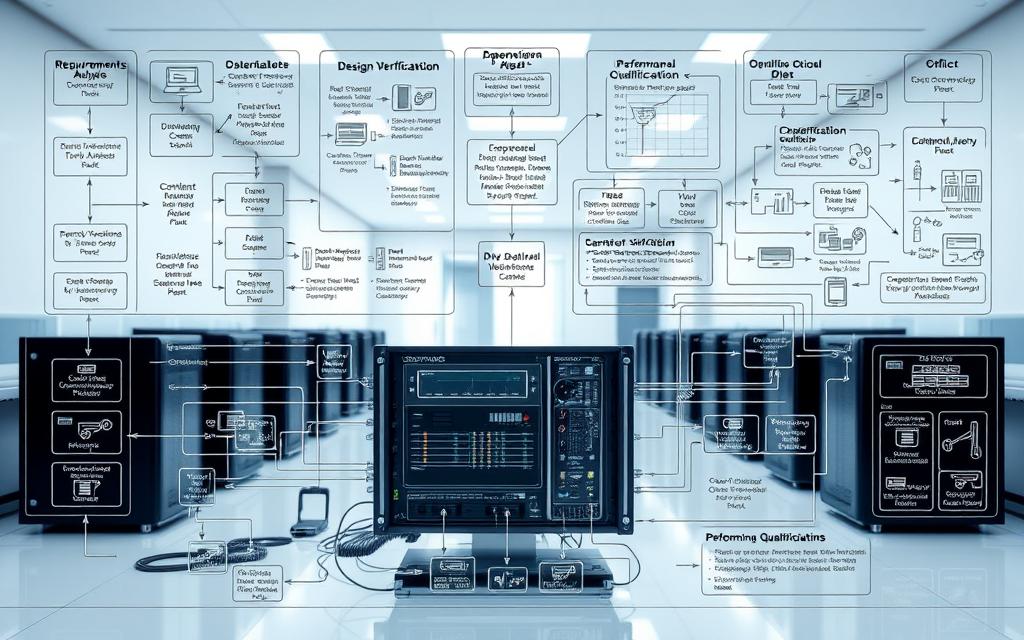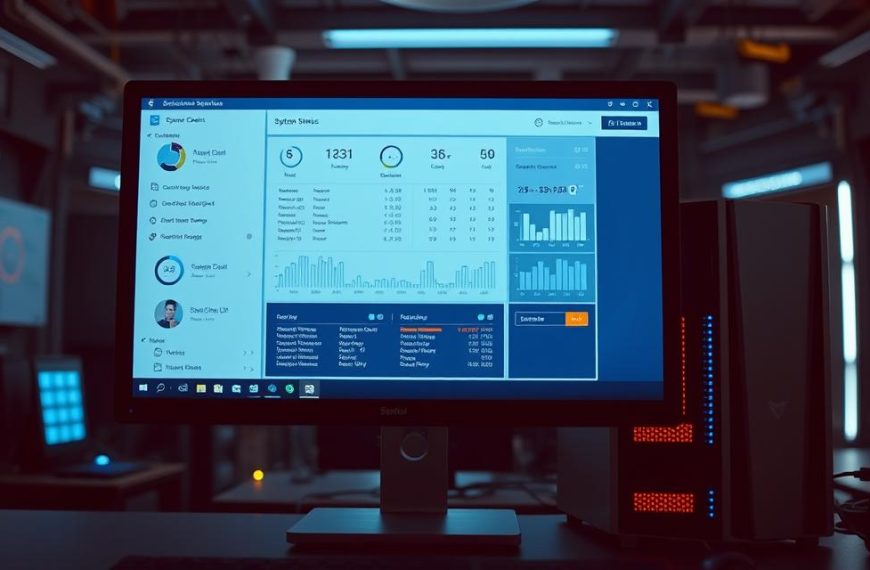In today’s world, making sure digital systems work right is not just smart—it’s the law. Computer system validation is a key process. It makes sure systems work as they should, every time.
This careful method is key to keeping data safe. It helps keep patients safe and products of high quality in fields like medicine and devices. The FDA and other groups make sure these rules are followed to keep things running smoothly.
Rashida Ray says that good validation means you can rely on your systems completely. It checks that each part of the system does what it’s supposed to, without any doubt.
For companies following these rules, knowing about computer systems validation is vital. It helps them stay legal and keep data safe. This knowledge is important for both the company’s success and public safety.
What is CSV Computer System Validation
Computer System Validation is key for making sure digital systems work right in controlled places. It mixes technical skill with following rules to make systems that always give good results.
Core Definition and Purpose
CSV is all about planning, making, testing, and using systems. The main CSV purpose is to show a system works as it should and is good for its job.
This process makes sure systems work the same way every time. It turns guesses into facts about how well systems perform. The whole process builds proof that systems are reliable.
Historical Development in Regulated Industries
CSV started because of quality needs in the drug and device fields. Rules makers saw that computer systems needed the same checks as physical ones.
Big problems with data led to CSV becoming a must in regulated industries. In the 1990s, the FDA and European regulators gave clear rules. This made CSV a must-do, not just a choice.
Now, CSV is used in more areas like biotech and healthcare. It keeps getting better to handle new tech like cloud computing and AI.
Essential Terms and Concepts
To get CSV, you need to know some key words:
- Validation: Showing through proof that a system works as planned
- Verification: Checking that a system meets its specs
- Intended Use: What a system is made for
- GxP Compliance: Following rules for quality systems
These ideas are the base of validation plans. They help match business goals, tech, and rules. Knowing them helps companies follow GxP compliance well.
The FDA Group says validation is not just a start but an ongoing job. It’s about keeping systems in good shape all the time. This view makes validation a constant quality effort, not just a one-time thing.
The Importance of CSV for Data Integrity
Data integrity is key in the pharmaceutical and medical device sectors. CSV ensures data stays complete, consistent, and accurate. This is vital for making important business decisions and following rules.
Defining Data Integrity in Computer Systems
Data integrity means information is accurate, complete, and consistent in computer systems. In regulated areas, it’s more than just being right. It’s about the whole life of the data. It means data can only change with permission.
Key traits include:
- Accuracy: Data correctly reflects reality or intended values
- Consistency: Information remains uniform across systems
- Completeness: All necessary data elements are present
- Reliability: Data can be trusted for decision-making
Computer system validation helps achieve these traits. The data integrity importance is huge in fields where data affects patient safety.
Consequences of Inadequate Validation
Not validating computer systems properly has big validation consequences. Agencies see it as a major quality system failure.
Common results include:
- Regulatory warnings and compliance actions
- Product recalls due to unreliable data
- Financial penalties reaching millions of dollars
- Damage to organisational reputation
- Potential risks to patient safety
These validation consequences show why strong validation is so important. The cost of not following rules is much higher than the cost of proper CSV.
Case Studies Highlighting CSV Necessity
Real-world CSV case studies show how vital validation is. One pharmaceutical company got in trouble for unauthorised data changes.
Another medical device maker had to recall products because of bad validation. These CSV case studies highlight how small mistakes can lead to big problems.
These examples point out common issues:
- Inadequate change control procedures
- Missing audit trail functionality
- Poorly documented testing protocols
- Insufficient staff training on data handling
These CSV case studies make it clear that validation is more than just following rules. It’s essential for business. Companies that focus on CSV avoid big troubles.
Key Principles Governing CSV
Computer system validation needs strict rules to keep data safe and follow laws. These rules are key for good validation in many industries.
GAMP 5 Framework and Its Application
The GAMP 5 framework guides how to validate computer systems. It focuses on how complex a system is and its risk level.
GAMP 5 aims for quality, safety, and data accuracy. It encourages teamwork between suppliers and users at every stage of a system’s life.
Software and Hardware Categorisation
GAMP 5 sorts systems into groups for different validation needs. This helps in using resources wisely.
Systems are grouped from simple to complex. Each group needs specific validation steps and documents.
| Category | System Type | Validation Approach |
|---|---|---|
| 1 | Standard Infrastructure | Qualification only |
| 3 | Standard Software | Configuration testing |
| 4 | Configured Software | Full validation |
| 5 | Custom Systems | Comprehensive validation |
Adopting a Risk-Based Validation Strategy
A risk-based strategy focuses on high-risk areas first. This saves time and keeps things compliant.
It starts with planning and goes on throughout a system’s life. It’s about finding and protecting key processes and data.
This strategy includes:
- Spotting where systems might fail
- Seeing how failures affect quality
- Putting in controls
- Recording how risks are managed
Documentation Standards and Audit Trails
Good documentation shows systems work as they should. It includes plans, tests, and summaries.
Audit trails keep electronic records of system actions and data changes. They show who did what, when, and why.
Good audit trails help keep data safe by:
- Keeping full records of actions
- Tracking who did what
- Recording when and why changes were made
Regulators want to see these records throughout a system’s life. They help show that validation was done right and prepare for inspections.
The CSV Lifecycle: From Planning to Maintenance
The journey of computer system validation is from start to ongoing success. It ensures systems work as planned and keep data safe. Knowing each step is key to good validation.
Initial Planning and User Requirements Specification
Good validation starts with careful planning and clear needs. Teams should talk to stakeholders early to get all the details. This avoids costly changes later on.
User Requirements Specifications (URS) outline what the system must do. These documents are the base for all validation work. They need to be clear and easy to follow throughout the CSV lifecycle.
System Design and Development Considerations
System design turns user needs into technical plans. Teams must create solutions that meet needs and follow rules. Design documents are key for checking if systems follow rules.
Choosing the right vendor is important here. Companies should look at suppliers’ quality and support for validation. Good design reviews help avoid problems before the system is used.
Validation Testing Phases
The testing phase shows if a system works right. It uses the IQ OQ PQ method to check reliability. Each part of this method checks different things about the system.
Installation Qualification (IQ) Procedures
IQ checks if the system is set up right. Teams document how it’s installed, the environment, and the steps taken. IQ makes sure the system is ready for testing.
Good IQ documents include lists of equipment, checks during installation, and records of the environment. These show the system was set up correctly in the right place.
Operational Qualification (OQ) Protocols
OQ tests how the system works under different conditions. OQ protocols check if the system works as planned. This phase finds out what the system can and can’t do.
Tests should push the system to its limits. If OQ is successful, it means the system is reliable before it’s tested in real use.
Performance Qualification (PQ) Execution
PQ checks if the system works well in real situations. PQ tests use real processes and materials. This final test makes sure the system meets all the requirements.
PQ tests often go on for a long time to check if the system works consistently. If PQ is successful, it means the system will work well in everyday use.
Ongoing Operation and Change Control
Validation keeps going as the system is used. It’s important to keep the system validated even when it changes. This needs strong change control processes.
Change management makes sure changes are checked and validated. Teams should look at how changes affect the system’s validation status before making them. Keeping good records helps keep the system validated as it changes.
Regular checks and updates help keep the system in line with rules. It’s important to have clear steps for dealing with problems and fixing them. These steps keep the system reliable and in line with rules.
Knowing the whole CSV lifecycle is key to success. For more on validation, see our detailed guide on computer system validation best practices.
Regulatory Expectations and Compliance
Following international rules is key for computer system validation in healthcare. Companies in regulated fields must deal with many rules. These rules cover electronic records, data integrity, and system reliability.
Global rules ensure computer systems keep data accurate and safe. These rules guide validation and ongoing checks.
FDA 21 CFR Part 11 Requirements
The U.S. Food and Drug Administration’s 21 CFR Part 11 sets rules for electronic records and signatures. It applies to records needed by FDA rules or used instead of paper ones.
Important points include access controls, audit trails, and system checks. Companies must show electronic signatures are as good as handwritten ones.
Change control is also key under FDA 21 CFR Part 11. Systems need version control and to document all changes.
EU Annex 11 Guidelines for Medicinal Products
The European Union’s Annex 11 gives specific advice for computer systems in medicine making. It focuses on risk-based validation and data integrity.
EU Annex 11 says suppliers and service providers must be checked for quality. It requires testing and documentation throughout a system’s life.
Data storage and protection are big under EU Annex 11. Systems must keep data safe with backups and protect against unauthorized access.
International Standards and Harmonisation
Global efforts aim to make computer system validation rules the same everywhere. This helps companies avoid doing the same work in different places.
Groups like the Pharmaceutical Inspection Co-operation Scheme (PIC/S) help make GMP standards the same. This makes it easier for countries to accept each other’s inspections and validation.
The International Council for Harmonisation (ICH) creates guidelines for computer system validation worldwide. These standards help companies follow the same international compliance rules everywhere.
| Regulatory Body | Key Focus Areas | Documentation Requirements | Audit Considerations |
|---|---|---|---|
| FDA 21 CFR Part 11 | Electronic signatures, audit trails, access controls | Validation protocols, change control records | Data integrity verification, system security |
| EU Annex 11 | Risk management, supplier qualification, data protection | Quality agreements, testing documentation | Process validation, backup procedures |
| PIC/S | GMP compliance, inspection standards | Validation master plans, audit reports | Cross-border recognition, quality systems |
| ICH | Quality risk management, technical requirements | Harmonised protocols, compliance certificates | International standards alignment |
To meet international compliance needs, companies must understand both the similarities and differences in rules. They should plan validation strategies that meet the toughest requirements in all places they operate.
Challenges in CSV Implementation
The path to full Computer System Validation is filled with big hurdles. Even with good plans and rules, companies face real problems. These can make validation less effective and slower.
Managing Costs and Resources
One big challenge is the cost of doing it right. Validation needs a lot of money, special people, and time. Many companies don’t think it’s as expensive as it is.
Some common problems include:
- Departments working alone, not together
- Technical teams and quality people not talking enough
- Not enough money for upkeep and updates
- Hard to get top bosses to agree to full validation
Validation expert Rashida Ray says, “CSV is not just a one-time thing. It’s an ongoing job that needs special resources and support.” This shows the need for proper planning and resources all the way through.
Adapting to Rapid Technological Advances
Fast changes in technology are another big challenge. New systems and updates need constant adaptation to stay compliant.
Some big issues are:
- Keeping up with cloud systems that change fast
- Adding artificial intelligence and machine learning
- Validating software that’s always being updated
- Keeping systems safe from cyber threats
This fast pace means validation methods need to be flexible. They must keep up with technology changes without losing data safety or following rules.
Sustaining Compliance Over Time
Keeping up with validation is hard after you start. Rules and standards change all the time.
To stay compliant, you need:
- Good ways to handle changes to systems
- Training staff on new rules
- Being ready for audits and keeping documents up to date
- Staying on top of new rules
Managing costs well is key here. Companies must weigh the cost of keeping up against the risk of not following rules. They often focus on high-risk areas first and plan for ongoing upkeep.
Working together across teams is very important. It helps break down barriers and fosters a culture of ongoing improvement in following rules.
Best Practises for Effective CSV
For CSV to work well, three key areas are important: planning, using technology, and training people. These areas work together to make strong validation systems. These systems meet regulatory needs while keeping operations smooth.
Creating a Comprehensive Validation Master Plan
A detailed validation master plan is essential. It outlines how to do validation, who does it, and when. It makes sure everyone is on the same page.
It includes risk checks and rules for documents. Tools like Microsoft Visio help show how systems work. It also makes sure everyone involved knows what’s needed.
The plan sets clear goals and knows what needs to be done. This stops things getting out of hand and keeps focus on what’s important.
Utilising Automation and Validation Tools
Today’s validation needs advanced technology. Automation tools cut down on manual work. They make validation more accurate and consistent.
Companies like Ideagen offer tools that make validation easier. These tools include:
- Automated test case execution and reporting
- Electronic signature capabilities compliant with 21 CFR Part 11
- Real-time validation status dashboards
- Integrated document management systems
Using these tools can cut validation time by 40-60%. It also makes data more reliable by reducing human mistakes.
Fostering Organisational Competency and Training
Keeping CSV up to date needs ongoing training. Companies should have training that covers both technical and legal aspects of validation.
Good training includes:
- Training on who does what in validation
- Keeping up with legal changes
- Learning how to use tools
- Sharing knowledge across teams
It’s important to check if staff are up to date. This is done through practical tests and quizzes. This keeps staff ready as things change.
“The most sophisticated validation tools cannot compensate for inadequately trained personnel. Human expertise remains the critical factor in successful CSV implementation.”
The table below shows how old ways compare to new ones in validation:
| Validation Activity | Traditional Approach | Modern Best Practice | Efficiency Gain |
|---|---|---|---|
| Requirements Documentation | Manual Word processing | Automated requirement management tools | 55% time reduction |
| Test Case Execution | Paper-based testing | Electronic validation platforms | 60% effort reduction |
| Change Control Management | Spreadsheet tracking | Integrated change management systems | 70% error reduction |
| Training Records | Physical filing systems | Electronic learning management systems | 80% retrieval time improvement |
Companies that follow these best practices do better. They have more success with validation and fewer problems in audits. Planning, using the right tools, and training staff well make a strong validation culture. This culture adapts to new rules and standards.
Conclusion
Computer System Validation is key for keeping data safe and following rules in fields like medicine and health. A good CSV process makes sure systems work right and protect important data. This summary shows how important it is to have a clear plan, based on GAMP 5.
Following best practices in CSV helps reduce risks and makes systems more reliable. Companies should focus on training, keeping records, and staying up-to-date with new tech and rules.
The future of CSV will see more use of automation and AI. These tools will make validation easier and keep it strict. Using these new technologies will help companies stay compliant and succeed in a changing world.



















